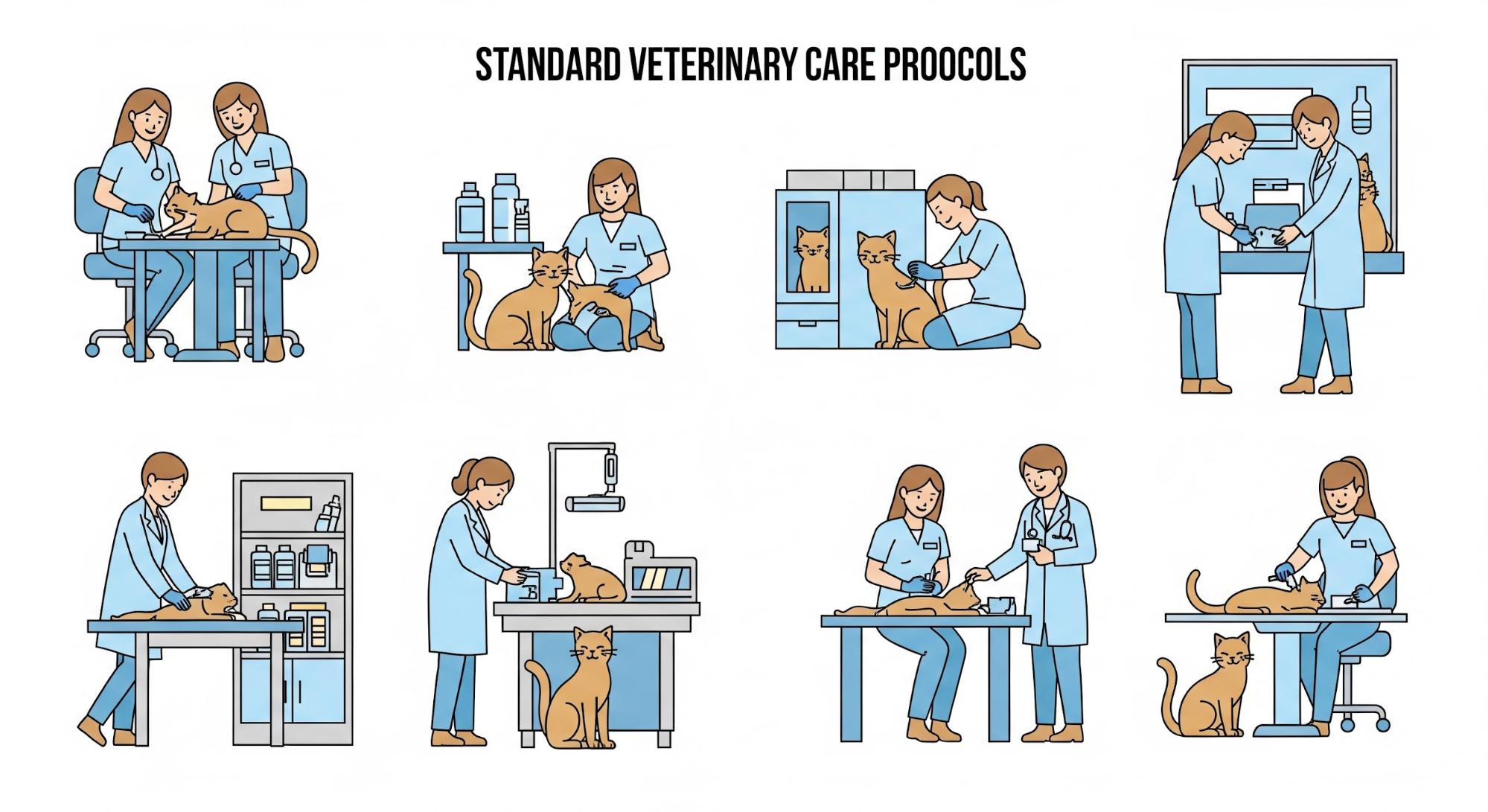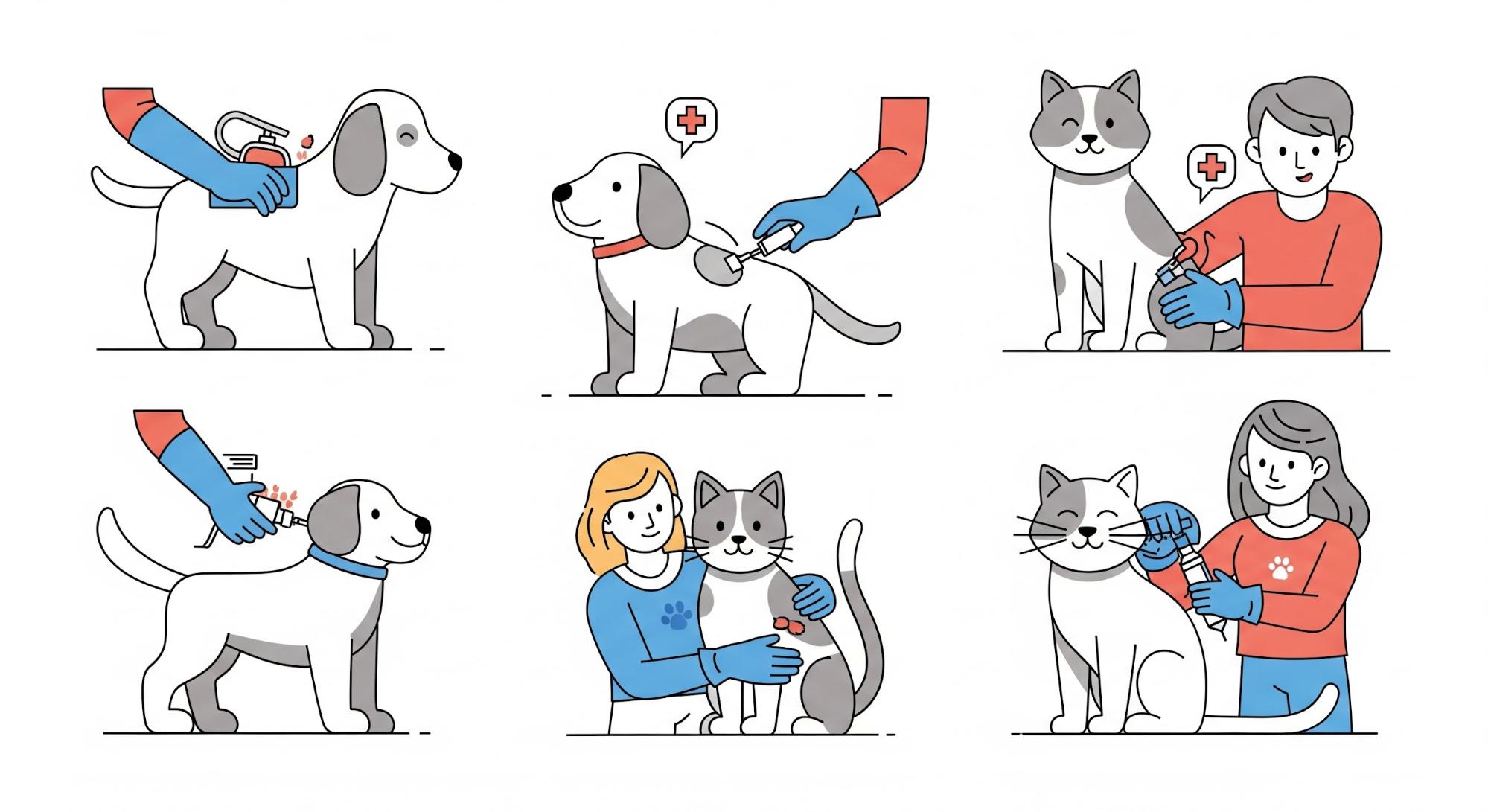Have you ever wondered what keeps rescued sanctuary cats healthy and thriving? It’s certainly a lot more than just warm cozy beds and endless gentle skin cuddles. Veterinary care protocols in cat sanctuaries are essential for ensuring that cats are safe and healthy.
These protocols and measures serve as silent guardians for furry little pets. They play an important role in stopping outbreaks, providing comfort, and supporting long-term health. These cat sanctuaries provide safe and caring places to rescue cats for healing.

For a veterinarian, a volunteer, or a cat owner, understanding these protocols highlights the real work that takes place behind these walls. Together, they create a structured system of care that shelters and heals, one whisker, one purr, and one rescued life at a time.
1. Intake Examination & Quarantine Protocols
Sanctuaries conduct intake exams on every new cat that arrives. Vets look for common health issues in sanctuary cats, such as parasites, skin diseases, and respiratory issues. The staff puts cats directly into quarantine afterwards to help prevent the spread of underlying sicknesses.
Isolation of the new cats prevents outbreaks from spreading in the first place. The caregivers monitor each cat closely, examine symptoms, and treat problems early. When veterinarians verify the good health of the cats, they are shifted to the main sanctuary population.
Once that is accomplished, the real emphasis is placed on preventive medicine that serves the whole colony.
2. Preventive Care & Vaccination Protocols
Sanctuaries depend on core vaccines to avoid severe feline illnesses. Rabies, panleukopenia, calicivirus, and rhinotracheitis vaccines constitute the basis of cat sanctuary veterinary practice.

Vets also give booster shots to pets when necessary, as close living conditions heighten disease risks. Vaccination shields individual cats and the colony at large.
With immunity intact, sanctuaries proceed with managing internal and external parasites that influence long-term health.
3. Worming and Parasite Prevention Protocols
Sanctuaries have strict schedules for deworming. They treat cats for roundworms, hookworms, and tapeworms every 1–3 months, based on risk and age. Preventative measures against fleas and ticks, usually administered monthly, maintain external parasites in check.
Worming on a regular basis decreases anemia, gastrointestinal issues, and malnourishment. These are prevalent conditions in rescued cats. Parasite control also decreases the transmission risk within colonies.
Suppliers support sanctuaries in maintaining these consistent programs. Professionals in veterinary sales jobs promote and ensure access to vaccines and other necessities.
Worming keeps cats healthy. However, spaying and neutering help ensure their long-term well-being. Now we’ll discuss the spaying and neutering protocols in cat sanctuaries.
4. Spaying and Neutering Protocols
Population control is important to maintain any cat sanctuary. Spaying and neutering cat programs prevent overcrowding and create a healthier, calmer environment.

Here are the key benefits:
- Prevention of overcrowding within colonies
- Reducing territorial aggression
- Improving the overall health of cats
By reducing reproductive stress, sanctuaries decrease hormone-driven behaviors like fighting and excessive roaming.
With the population under control, sanctuaries can direct their resources toward providing quality care rather than handling crises. After surgery, regular monitoring helps ensure a smooth recovery and reduces the chance of complications.
5. Daily Health Monitoring Protocols
Volunteers and staff members monitor each cat daily. They monitor changes in appetite, coat health, or social manners. Hence, veterinary treatment for rescued cats is effective and vital before their diseases worsen.
In-depth health records allow sanctuaries to recognize patterns and develop successful treatment plans.
Even support industries have a role here. People working in vet related jobs also play a part in ensuring cat care. Animal care workers and veterinary technicians offer the hands and eyes that enable this kind of support to happen.
Daily monitoring is just the first step. Sanctuaries also follow strict treatment protocols and provide veterinary care to keep cats healthy.
6. Treatment Protocols & Veterinary Care
Veterinarians move fast when cats begin to exhibit illness. They prescribe antibiotics, treat wounds, provide fluids, and treat chronic illness. Such organized veterinary care schemes save lives and decrease pain.
Every treatment is individualized to the condition of the cat. Rescues tend to come in with complicated medical backgrounds, so a personalized plan is necessary.
After treatment is initiated, sanitation and environment facilitate long-term recovery and general health.
7. Sanitation & Environmental Controls
Sanctuaries safeguard health through cleanliness. Workers disinfect cages, clean litter boxes, and change bedding every day. These measures fortify feline health protocols and stop germs from infecting other animals.

Prevention of parasites goes into the environment as well, with flea combing, insect control, safety, and routine vacuuming. Such measures keep colonies free from reinfestation.
Now, let’s turn our attention to behavior and surroundings with behavior and environmental protocols.
8. Behavioral & Environmental Protocols
Cats require something more than medicine; they require peace of mind. Sanctuaries offer toys, climbing posts, and peaceful resting places to alleviate stress. Human caregivers also provide gentle human contact.
Minimizing stress aids disease prevention in cat colonies. Healthy cats remain well and recover more quickly when illness strikes.
Sanctuaries such as Archie’s Cat Sanctuary show how enrichment and medical care go hand in hand, creating a standard for others to emulate.
Now let’s wrap things up with the final thoughts.
Cat sanctuaries are not just safe havens, but also formal systems of care where medicine and compassion overlap. Every rescued cat has a survival story. Sanctuary protocols provide them the opportunity to create a healthier future.
By investing in veterinary care protocols in cat sanctuaries, you’re not just preventing disease. You’re creating stability, comfort, and dignity for the most vulnerable felines. Each examination, vaccine, or enrichment activity represents a step toward healing and hope.
If you’re a vet, volunteer, or animal lover, your role matters. Support sanctuaries, share their mission, or offer your skills.
When organized care meets human kindness, every cat thrives; they do more than just survive.
FAQs
How frequently should sanctuaries vaccinate cats?
Sanctuaries typically follow veterinary advice to give kittens a series of full vaccinations early on. Then, they administer boosters annually, after one year, or every three years. The specific timing may vary depending on the population size, exposure risk, and local disease prevalence.
How frequently should worming medication be given?
Deworming is typically conducted monthly to every three months, depending on age, lifestyle, and previous exposure to parasites. External parasite management, such as prevention of fleas and ticks, is often administered on a monthly basis.
Why is it so important in sanctuaries to spay and neuter?
Spaying and neutering prevent overpopulation, minimize the stress of constant breeding, and decrease the risk of cancers associated with hormones. In addition to these medical advantages, they encourage calmer group interactions. It results in fewer battles and marking in common areas.
Sara Williams
Sara Williams is a professional content writer specializing in animal healthcare and veterinary topics. Her work provides pet owners and veterinarians with insightful, well-researched information to improve animal care.